
Let’s be honest: the internet has made life so much easier. We can shop online, pay bills with a few clicks, and manage our finances from the comfort of our couch. But here’s the thing—this convenience comes with its own set of problems. Cybercrime is on the rise, with financial fraud costing billions globally. According to Cybersecurity Ventures, cybercrime is expected to cost the world $10.5 trillion annually by 2025.
Here’s the good news—AI chatbots are stepping in to save the day. These clever virtual assistants aren’t just here to answer your questions or check your bank balance anymore. They’re becoming powerful tools that help detect fraud, prevent cyber threats, and make financial systems safer and more secure for everyone.
So, how are AI chatbots doing this? Let’s break it down and explore how they’re changing the game in the fight against fraud and cybercrime.
Can AI Chatbots Prevent Fraud?
First things first: What are AI chatbots? You’ve probably interacted with one at some point when you had a question about your bank account or needed help with a transaction. AI chatbots are powered by artificial intelligence, machine learning, and natural language processing (NLP). They’re programmed to learn from data, understand user requests, and respond quickly—almost like having a helpful assistant available 24/7.
But here’s the thing—AI chatbots aren’t just about helping customers with simple inquiries like “What’s my balance?” or “Can I change my password?” They’re also equipped to monitor transactions, spot threats, and keep financial accounts safe from sneaky fraudsters. Their ability to analyze data in real-time makes them great at catching fraud or other suspicious activity faster than traditional systems.
With their advanced learning capabilities, AI chatbots can spot patterns that humans might miss—making them essential tools for fraud prevention and cybersecurity.
How Do AI Chatbots Detect Fraud?
AI chatbots use machine learning and pattern recognition to spot red flags in financial transactions. They can identify anything out of the ordinary—whether it’s a sudden purchase in a different country, an unusually large transaction, or logins from unfamiliar devices. They analyze millions of transactions and data points in real time, allowing them to act as the first line of defense for financial institutions.
Here are a few ways AI chatbots are detecting and fighting fraud:
1. Monitoring Transactions in Real-Time
Think about how many transactions happen in a bank every single second. It would be impossible for a human to track all of them. That’s where AI chatbots come in. They can process thousands (even millions) of transactions at lightning speed and flag anything that looks suspicious.IBM’s AI in Cybersecurity Report showcases how AI systems monitor financial activity effectively.
For example:
- If you’re typically spending money in one city and suddenly make a purchase from a country halfway across the world, an AI chatbot will pick that up.
- If a transaction is much larger than your usual spending pattern, it can raise a red flag.
These bots are always watching, so they can notify financial institutions immediately if they spot anything odd.
2. Using Behavioral Biometrics for Extra Security
Have you ever heard of behavioral biometrics? This is a fancy way of saying that AI chatbots track your habits to verify that it’s actually you trying to access your account. They analyze behaviors like typing speed, how you move your mouse, or how you navigate an app. According to the Biometric Institute, this technology is rapidly becoming a key cybersecurity tool. If your habits suddenly change—like logging in from a new device or typing in a way that’s different from how you normally do—an AI chatbot will catch it.
This helps financial institutions ensure that stolen login credentials can’t be used by hackers to access your account. It’s like having an extra layer of security that only you can provide.
3. Learning and Adapting to New Threats
Fraudsters are always finding new ways to sneak into financial systems. But guess what? AI chatbots are smart enough to learn from these new schemes. They use historical data to detect trends and adapt to changing fraud patterns.
The more data they process, the better they get at spotting suspicious activity. It’s like having a super-smart assistant who’s always one step ahead of the bad guys.
AI Chatbots and Cybersecurity
AI chatbots aren’t just good at fighting fraud—they’re also helping to strengthen cybersecurity across financial platforms. With cyberattacks becoming more advanced, financial institutions need fast and efficient tools to respond. This is where AI chatbots come into the picture.
Here’s how they’re stepping up their cybersecurity game:
1. Fast Response to Threats
If a hacker tries to gain access to your bank account or a suspicious activity is detected, time is critical. AI chatbots can respond to threats instantly. They can stop transactions, isolate accounts, and alert the cybersecurity team to investigate before any major damage is done.
Think of them as the superheroes of cybersecurity. They don’t wait for a human to spot the issue—they act immediately to protect you and your money.
2. Sending Alerts to Users
Sometimes fraud can go unnoticed by account holders until it’s too late. AI chatbots can prevent this by sending real-time alerts if anything suspicious happens. These messages could look like this:
“We noticed an unusual login attempt from an unrecognized device. If this wasn’t you, please contact our support team immediately.”
These alerts give customers the ability to act quickly—whether that’s by confirming their transactions or freezing their accounts until the issue is resolved.
3. Helping You Stay Informed About Cybersecurity Threats
Not all fraud originates with hackers. Sometimes, users fall for scams like phishing emails or fake websites because they aren’t aware of the warning signs. AI chatbots can educate customers about common scams and how to avoid them.
They can send helpful tips like:
- How to create a strong password.
- How to spot phishing links.
- How to identify legitimate communications from your financial institution.
By keeping users informed, AI chatbots reduce the chances of customers becoming victims of fraud.
How AI Chatbots are Shaping the Future?
The fight against fraud and cybercrime is far from over, but with AI chatbots on our side, we’re making great strides. These virtual assistants are already improving the way financial institutions combat threats, and their role will only grow as technology advances.
In the coming years, we can expect even smarter features, like AI-powered predictions that can identify potential threats before they occur and even more advanced forms of user authentication using biometric data.
Financial institutions and their customers are lucky to have AI chatbots as part of their cybersecurity team. These intelligent virtual assistants are here to stay—and they’re making the digital financial world safer for everyone.
Conclusion
AI chatbots are so much more than just virtual customer assistants. They’re powerful tools that are revolutionizing fraud detection, improving cybersecurity, and offering financial peace of mind to millions of customers.
With their advanced pattern recognition, real-time responses, and ability to educate users, AI chatbots are proving to be an invaluable part of the financial security landscape.
So the next time you chat with your bank’s AI assistant, remember—you’re not just talking to a chatbot.
Ready to elevate your security and customer experience? Explore BeyondChats Today!




